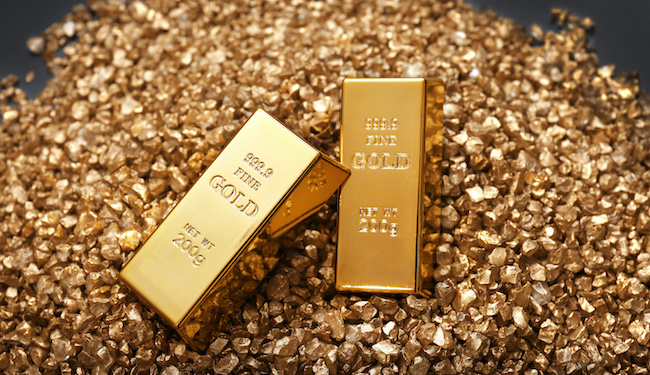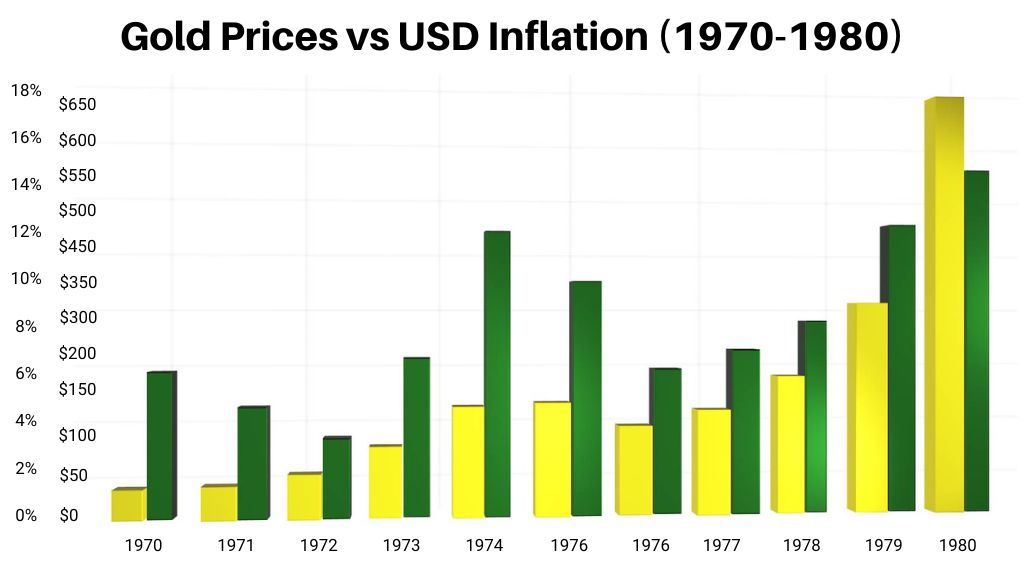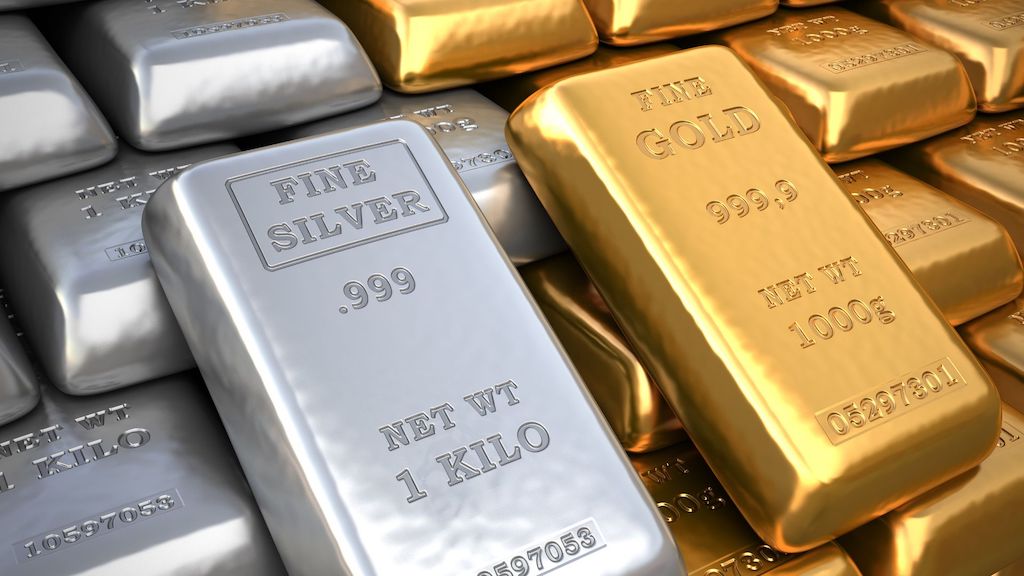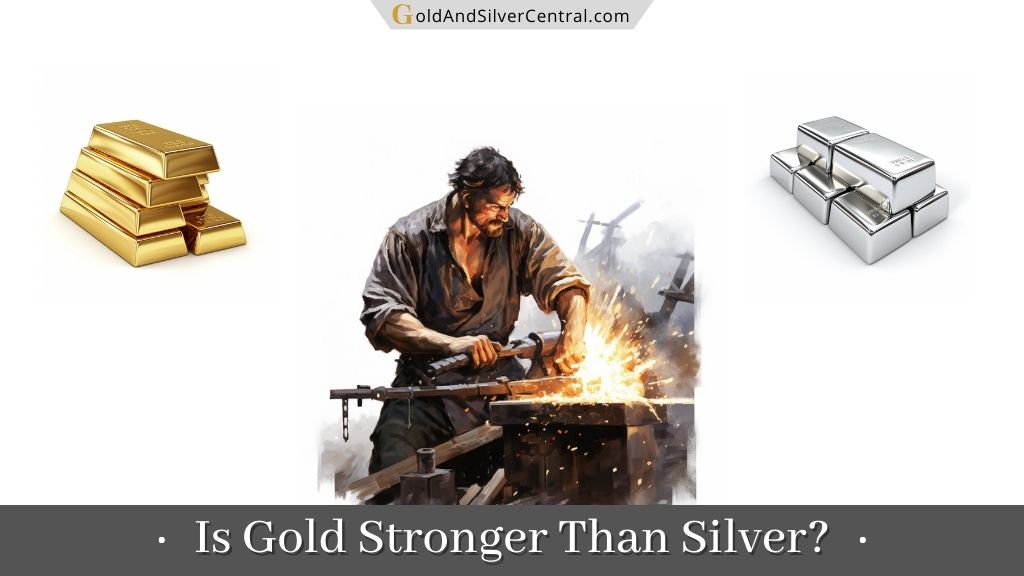Let’s face it:
Gold and silver are like the rock stars of the precious metals world, always in the limelight with their irresistible charm.
And we all know that in our society, they serve both practical and symbolic roles.
Today, we’ll cover the following:
- Is gold stronger than silver?
- Or is silver more durable than gold?
- Which is better, gold or silver?
Now, the goal here isn’t to pick a winner.
We’re just aiming for a better understanding of these two elements. After all, they’re a big deal in our economy, technology, and culture.
Specifically, we’ll talk about their physical characteristics and diverse uses, and pit their durability and versatility against each other.
With that said, let’s get started.
Physical Properties of Gold and Silver
The best way to compare these two precious metals is to understand them at their core.

What makes them unique and different from each other?
Gold
Its fancy scientific name is Au (coming from the Latin ‘aurum’).
That shiny yellow stuff has been turning heads for ages. But there’s more to it than just good looks:
- Malleability and Ductility
Gold is super malleable and ductile. What’s that mean? Well, you can hammer it into thin sheets or stretch it out into skinny wires without it breaking. Handy, right?
- Corrosion Resistance
This precious metal doesn’t play well with most acids and bases, which is a good thing. It means it doesn’t rust or tarnish. That’s why it’s perfect for stuff like jewelry and coins.
- Electrical Conductivity
Gold is a good conductor of electricity, and because it does not tarnish, it is used in high-quality electronic connections.
- Density
It is dense, about 19.3 grams per cubic centimeter. That makes it one heavy metal.
Silver
This element goes by Ag in the science world (from the Latin ‘Argentum’).
It’s a shiny white metal turning heads just like its yellow friend. Silver shares some properties with gold, but it’s got its own unique traits too:
- Malleability and Ductility
This precious metal might not be as bendy as gold, but it’s still pretty ductile. You can shape it into different forms and thin wires.
- Tarnish
Unlike the yellow metal; silver does tarnish. That means it reacts with stuff like sulfur or hydrogen sulfide in the air.
Sure, you can clean it off, but it’s something to think about for uses where looks matter.
- Electrical Conductivity
It takes the cake for being the most electrically conductive element. So, it’s often used in high-quality electronic connections and other electronic parts.
- Thermal Conductivity
This metal has the highest thermal conductivity of any element. It also reflects like nobody’s business, which makes it great for things like mirrors, telescopes, and solar cells.
- Antibacterial Properties
Silver ions don’t get along with bacteria, viruses, algae, and fungi. This makes silver handy for medical uses and water purification.
What’s More Durable, Gold or Silver?
When talking about longevity, both these metals have pros and cons. It really comes down to what you’re using them for.
Gold
It’s a naturally tough guy.
It doesn’t like to mix with most acids, it won’t tarnish, and rust is pretty much a no-show.
This means gold can keep its good looks for a long, long time. Think about all those ancient yellow metal artifacts that are still sparkling today!
(If it does turn green, then it’s likely fake gold that won’t last long.)
But every tough guy has a soft side.
In this precious metal case, it’s literally soft. This makes it easy to mold into different shapes, which is excellent for things like jewelry making.
But it also means gold can scratch or bend easier than some other metals.
This is why you’ll often find it mixed with other metals (we call this an alloy) to make it more resistant to the rough and tumble of everyday life.
The alloys also affect the color and are the reason why sometimes the gold is too yellow, white, or with reddish hues.
Silver
Now, this precious metal is a bit harder than its yellow counterpart. Its extra hardness means it’s not as easy to scratch or bend, which can be a big plus in lots of situations.
The downside is that when in contact with air and certain chemicals, it can get a layer of tarnish (or silver sulfide) on the surface.
Sure, you can polish this off, but it means it needs a bit more TLC to keep it looking good.
And if you’re using it in a situation where you need the metal to be super pure, tarnish can be a problem.
So, there is no outright winner in this durability face-off.
The first one doesn’t tarnish. But it’s also a bit of a softie, so it’s more likely to get scratched.
The second one is tougher, but then again, it has a tarnish issue.
So when all’s said and done, the choice between gold and silver really depends on what you’re using the metal for.
It’s all about picking the right horse for the right course!
The Versatility of Gold vs Silver
These precious metals have a broad spectrum of uses, from jewelry and coinage to industrial and technological applications.

But which one is more versatile? Let’s talk about that.
Gold
This metal is pretty cool. It doesn’t corrode, is super malleable, and is excellent at conducting electricity – making it versatile.
Think about all the bling you see. A lot of that is made from gold because it’s so easy to shape, and, let’s be honest, it looks pretty awesome.
But it’s not just about looking good. It’s also got some serious skills in the electronics world because it’s a reliable conductor and doesn’t corrode.
And in case you didn’t know, gold even makes its way into our mouths as fillings and crowns in dentistry.
Silver
First, you’ve probably noticed a lot of jewelry is silver. It’s not as pricey as gold, but it’s great for crafting all kinds of designs.
But that’s not its superpower.
This metal is actually the top dog when it comes to electrical and thermal conductivity. Nothing else comes close.
Its conductivity game is strong, making it essential for creating stuff like batteries, electronics, and solar panels.
It’s also amazing when it comes to reflecting light, so it’s the go-to for mirrors and photography.
Don’t forget its health benefits too. Silver is a secret weapon in medical treatments because it’s got that natural germ-fighting talent.
So, which one takes the crown for versatility?
Well, both of these metals are pretty impressive. It boils down to what you need it for, how much you’re happy to shell out, and what look you’re going for.
Gold might be the king of bling, but silver has its own superpowers that make it the top pick for many other aspects.
Monetary and Symbolic Value
Needless to say, gold and silver have been widely used and appreciated throughout the human history.
They’ve been the stars of the show in different cultures and civilizations all over the world, and they’re pretty a big deal in the money department too.
You know, back in the day, these metals weren’t just something you wore around your neck or wrist; they were actual money.
You could go buy bread with a piece of gold. We don’t do that anymore, but these metals still have big bucks written all over them.
They’re like safety nets during shaky times, storing value even when everything goes downhill.
Gold
Right now, it’s worth more than silver if we’re talking money.
It also saves the day by preserving wealth over the long haul. Banks all over the world even keep gold tucked away for a rainy day.
We can see many instances of that in history.
For example, the 1970s were a highly inflationary period of time, but by the 1980 the gold outperformed inflation:

On top of that, its everlasting shine and refusal to tarnish have made it a symbol of things that last forever – like power.
Many cultures see gold as a representation of the sun, wealth, and even the divine.
Do you ever wonder why the top athletes get this medal? It’s because it stands for top-notch achievement.
Silver
But don’t count this precious metal out.
Silver may not be worth as much, but it’s still got a pretty penny to its name.
It’s like the gold’s more affordable cousin and a popular choice for people looking to invest without breaking the bank.
Now, this metal’s got its own symbolism game going strong. It’s been linked to the moon, the sea, and various goddesses in different stories and myths.
For many, it symbolizes purity, clarity, focus, and never giving up. You’ll often see it in ceremonial objects and rituals.
Without a doubt:
The big bucks and symbolic meanings of gold and silver are a big part of why we’re so drawn to them.
They’ve got deep roles in our economies and societies, shaping our ideas about wealth, success, and status.
This leads us to the next section…
Gold and Silver As An Investment
This info guide wouldn’t be complete if we didn’t look at it from the investment perspective.

If you’re thinking about investing in these precious metals, there’s a lot to consider, but don’t worry, we’ve got you covered.
Gold
When people talk about putting their money into something that can stand the test of time, they often think of this precious metal.
It’s been the go-to investment for, like, forever because it keeps its value and provides a safety net when the economy decides to go on a rollercoaster ride.
Sure, past performance does not guarantee future results but it is great if you’re looking to spice up your investment portfolio.
It usually doesn’t move in the same direction as stocks and bonds so that it can balance things out.
And, whether you’re into the real thing (we’re talking shiny bars and coins here) or you’d rather keep it digital with ETFs or tokens, there’s an option for you.
There are a couple of things to keep in mind though:
1) Unlike stocks or bonds, it doesn’t give you regular payouts like dividends or interest.
2) If you go for physical ones, you’ve got to think about where to keep it and how to insure it.
In this case, many people choose to invest in a gold IRA.
Check out this short video if you don’t know what that type of investment is:
Augusta Precious Metals is our go-to company when buying gold and silver in an IRA. (But they can help with cash purchases, too.)
Silver
It might not get as much attention as gold, but it’s got some cool features of its own.
First off, this metal is usually cheaper than its yellow counterpart, so it’s great if you’re just getting your feet wet in the world of precious metal investing.
And thanks to its industrial uses, like in electronics and solar energy, there’s always demand for it.
Plus, its price can jump around a lot more than gold, which means there’s a chance for big profits. But remember, with big potential rewards come big risks.
Like gold, investing in silver won’t give you a regular income, and if you’re into physical ones, you’ll need to consider storage and insurance costs.
So, which one is a better choice for investors?
It really boils down to what you want out of your investment, how much risk you’re willing to take, and how you think the market’s going to move.
Both can be a good guard against inflation and shaky economies, but they’ve got their own quirks. Before you dive in, be sure to do your homework or chat with a financial advisor.
Which Is Better: Gold or Silver?
I’ll be honest:
That’s like asking if pizza is better than burgers – it all depends on your taste (or, in this case, your specific needs and goals).
These two precious metals share some pretty neat characteristics – they’re durable, versatile, and have been used as money for thousands of years.
But they’re also unique in their own ways, and those differences could make one shine brighter than the other for you.
Now, if we’re talking about investing, that’s another ball game.
Gold’s been the go-to investment for ages. It’s steady, reliable, and can be a lifesaver when the economy starts to feel like a rollercoaster.
It’s kind of like the comfort food of investments – it might not always be exciting, but it’s something you can count on.
The downside? It doesn’t give you regular payouts like dividends, and the price tag can be a bit hefty for some folks.
On the flip side, we’ve got silver.
It’s cheaper than the yellow metal, so it’s easier on the wallet for those just starting or looking to invest smaller amounts.
But with its affordability comes more ups and downs in price, which could mean higher rewards or bigger losses.
Another point to consider is that silver is used in loads of industries, so demand for it can drive up its price.
So, which is the better bet?
Well, it depends on you.
Are you the play-it-safe type looking for a stable, long-term investment? Gold’s probably your guy.
If you’re willing to ride the wave of risk for the chance of bigger rewards, then you might want to hang ten with silver.
We also encourage you to check out our #1 recommend Gold IRA company in the United States – Augusta Precious Metals.
They can help you diversify with gold and silver in an IRA and answer the questions you may have about this type of investment.
If that’s something that interests you, then call the Augusta team at (833) 989-1952.
You can also grab their guide here and get a FREE GOLD coin when you open an account with them.




